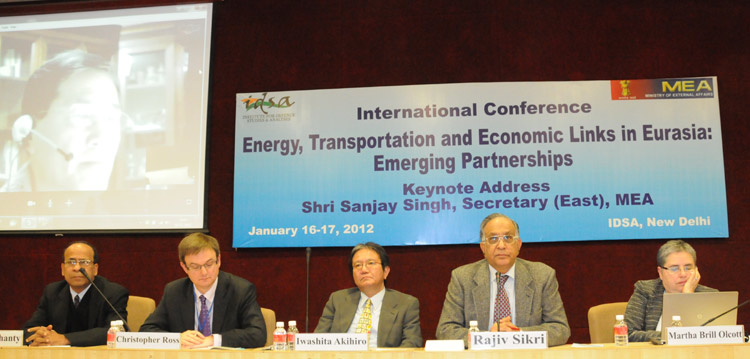You are here

Chair: Ambassador Rajiv Sikri
Panellists: Zhao Huasheng, Martha Brill Olcott, Iwashita Akihiro, Christopher Ross and Arun Mohanty
The panellists in this session discussed the role and influence of major external powers in the Central Asian region.
Professor Zhao Huasheng highlighted the significance of Central Asian region for China. Energy security, diversification of energy supplies and new transport linkages remain key priority areas. China imports close to fifty percent of its gas from Central Asia. He referred to China as a ‘bridge’ and a key transport link in Eurasia that links Europe with Asia.
Dr. Martha Brill Olcott argued that one of the major features of U.S. policy in Central Asia is to encourage the development of new transportation outlets in the region in order to increase their access to global markets and to decrease their dependence on Russia as a gate keeper. The policy is also designed to try and remove Iran from the Central Asian transport equation. Moreover, recent trends indicate that China has emerged as a major player in the region and will continue to do so. She dwelled on the US advocacy of “multiple pipelines” for the export of the region’s oil and gas. The U.S. government has staunchly defended two routes in particular; the Trans Caspian route to send oil and gas through pipelines from Turkmenistan and Kazakhstan to Baku and then on to Europe through the Baku Tbilisi Ceyhan, and Baku Tbilisi Erzerum pipelines on to Europe and the TAPI pipeline. In addition, the U.S. has also supported the creation of new transport linkages between the region and the outside world, but has allowed CAREC (Central Asian Regional Economic Cooperation) of the Asian Development Bank to take the lead on most of these projects. She was of the opinion that the US has been in search of partners to solve the problem of instability in Afghanistan.
Mr. Iwashita Akihiro highlighted the border dynamics in Eurasia. He dwelled on the Russia-China strategic partnership for resolving border issues; the role of the Shanghai Cooperation Organization (SCO) in negotiating border disputes between China and Central Asian countries, the Vietnam-China agreement on the issues of inland borders and developments in Tonkin Bay which have all resulted in the establishment of peace and stability in the region. Mr. Akihiro explained the concept of multinational initiatives, and listed the future possible alliances in the form of India-Russia-China-US quadrilateral and India-China-Japan-Russia-US pentagon. However, in order to achieve this, countries of the region must remove years of mistrust and mutual differences. He argued that while India has been able to project itself as a land power, it still lacks the ability to project itself as a true maritime power. There should be a new dimension to the issue of connectivity between maritime and continental Asia. Mr. Akihiro felt that cooperation through dialogue is the best way forward and there is a need to institutionalize cooperation amongst nations.
Mr. Christopher Ross highlighted the importance of EU’s new developing partnership with Central Asia that aims to cover a wide range of issues including trade and economics and said that it is not limited to energy cooperation. Establishment of a southern gas corridor has been a priority area of EU’s energy cooperation with Central Asia.
Professor Arun Mohanty dwelled on the importance of promoting India’s economic cooperation with Russia, which he felt was way below its true potential. He highlighted the key areas including pharmaceuticals, fertilisers, financial services, power, health, chemicals and aviation where India should look to tap into the Russian market and the need for both state and private sector to work together to give a new direction to the economic relationship. Prof. Mohanty argued that at a time when the world is facing an economic slowdown, Indian and Russian economies can be natural partners in reviving growth, creating infrastructure and generating surpluses. Russia’s entry into the WTO has opened up new avenues for cooperation and India has discussed the option of a Comprehensive Economic Partnership Agreement with the Customs Union comprising of Russia, Belarus and Kazakhstan. India should also participate in Russia’s massive modernization programme. He felt that policy makers should address bottlenecks in the form of connectivity issues, inadequate banking and financial services, lack of brand promotion, removal of discrimination in insurance coverage and quality control concerns.
Col Khrushchev argued that although the need for economic integration is often talked about, not much discussion has taken place over the ways and means to implement it. In the future, effective border management will be a challenge. Lessons need to be learnt from Russia’s mistake of over-integrating the region and policy planners should now focus more on economic rather than geo-political issues.
The discussions brought to light the following major points;
a) Greater economic cooperation amongst states can help minimise tensions in the region.
b) The US is concerned about China’s increasing engagement with Central Asia.
c) The US has tried to engage with SCO at track II levels but it is difficult to predict the future.
d) Lack of unanimity amongst the Central Asian countries is often exploited by external powers as part of the ‘great game’ played in the region.
